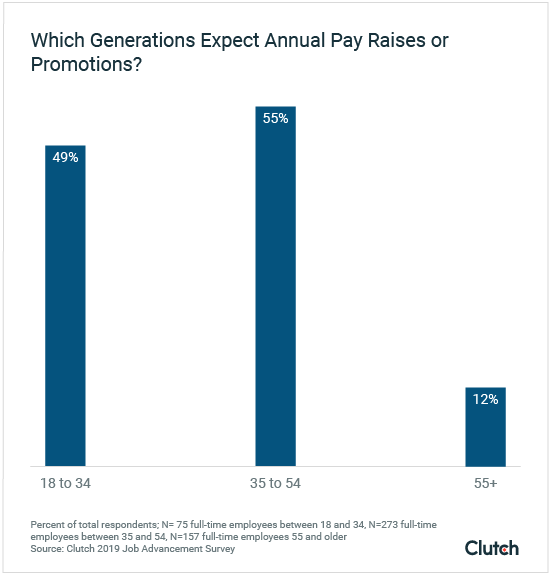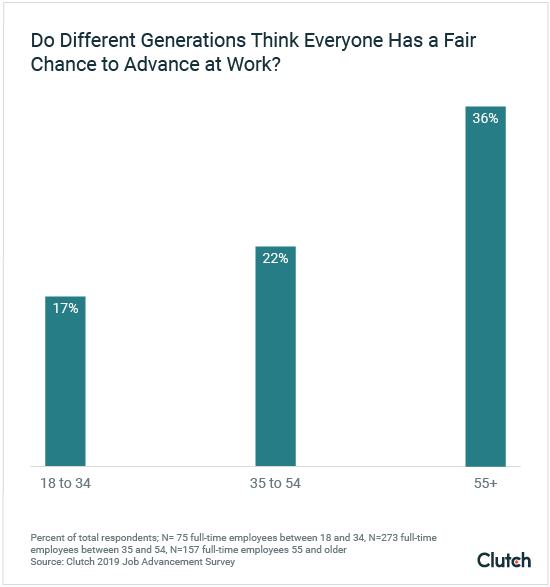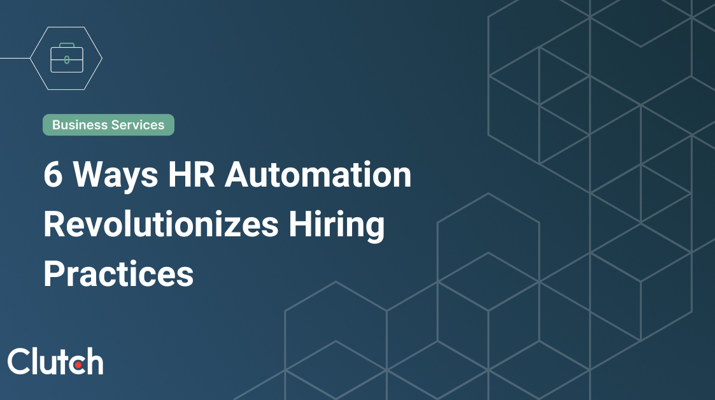

Updated December 10, 2024
Employees want to improve at their jobs and advance at work. Companies should provide clear direction for job advancement to promote employee growth, according to our survey of 505 full-time U.S. employees. Businesses must understand worker concerns about advancement and consistently raise employees’ level of responsibility to help them improve and advance.
Updated 05/05/2022
In a tight labor market, companies are focused on improving all aspects of their employee experience. A satisfying employee experience is more than flashy perks and benefits, however.
Looking for a Human Resources agency?
Compare our list of top Human Resources companies near you
Another important part of an employee’s experience is the opportunity to take on more responsibility and advance at their job. Some believe that there's a secret formula or key personality traits that lead to promotions. At your company, it's important that employees understand exactly how employees are promoted.
We surveyed 505 full-time employees to learn about their experience adding responsibilities and receiving promotions.
We found that the expectations employees hold for career growth depend on whether the advancement is “hard” or “soft.”
Employee attitudes about advancement also are largely affected by age. Younger employees are far more likely to expect yearly promotions.
To provide employees with the support to advance, companies should:
Need help with employee promotions at your company? Hire an HR company to support your efforts.
Through our survey research, Clutch composed four tips for establishing a strong promotion process within a business.
Companies that keep these four promotion tactics in mind will cultivate a positive culture surrounding internal promotions for years to come.
Businesses should give successful workers additional tasks and responsibilities each year.
This shows employees that they are improving and reduces the chances they will leave the company for a job with more learning opportunities.
Two-thirds of employees (67%) expect to add tasks and responsibilities to their workload every year they are employed at their company.

Meanwhile, fewer than half of employees (46%) say workers at their company actually achieve gradual increases in responsibility every year.

Gradual increases in the amount of work and supervision an employee is responsible for is called “soft advancement.”
Soft advancement is integral to employee satisfaction and performance. Consider the experience of two different employees, both of whom have had their job for one year:
Which employee is likely to feel more fulfilled? Which is likely to show long-term loyalty to the company they work for?
Joe is more likely to feel excited about his work and his position within his company. He has now seen firsthand that at his company, hard work is rewarded. Suzanne will likely feel bored and neglected. She may look aggressively for a new job where she is granted opportunities to develop and improve.
Companies should provide workers with frequent soft advancements by increasing their responsibilities.
Offering yearly pay raises, promotions, and “hard” advancements, however, aren’t always necessary for employee morale and success. Companies should also anticipate young workers leaving jobs more frequently to create their own hard advancements.
Only 40% of employees say that workers at their company achieve hard advancements such as pay raises or official promotions every year.

Providing employees hard advancements each year is difficult because companies rarely have the need for employees to assume entirely new roles or the funds to provide pay bumps to every employee.
Instead, companies should understand that young workers are what Norhanie Pangulmia, content marketing executive at SIA Enterprises, a boutique marketing agency for startups, calls “driving job-hoppers.”
A substantial portion of millennials will create their own hard advancement by leaving for a new role at a different company – even if their company offers clear opportunities to advance and improve.
Companies can craft intelligent and effective employee advancement policies by understanding that yearly promotions are not a sustainable way to manage a workforce and that employee turnover is a natural part of running a 21st century business.
Even though annual staff promotions aren’t required to indicate career growth, a promotion is representative of a significant milestone and achievement in an employee’s career path. On a personal level, a promotion increases morale through company-wide recognition of hard work.
Studies show that how people are celebrated and promoted can make or break a corporate work culture.
Promotions are personal, but companies that set clear expectations regarding promotions and communicate advancements effectively will find that promotions inspire and encourage quality work across the company.
Communicating employee promotions to the team is just as important as making promotion decisions themselves. It’s essential to secure support and buy-in from the team as a whole to make promotions run smoothly.
When a new job opening pops up for internal candidates, everyone will be curious and interested to learn who will get promoted into the position.
When announcing the promotion to the team, here are some best practices to follow to earn support:
Your team will enjoy celebrating the newly promoted employee, especially while remembering all of the hard work they did to earn their new role.
Companies must provide early and mid-career workers clear, regular opportunities to earn hard advancements such as pay raises.
Regular advancement is especially important to employees between 18 and 54. Only 12% of workers 55 and over expect to receive hard advancements every year, compared to roughly half of workers between 18 and 34 (49%) and 35 to 54 (55%).

In comparison, roughly half of workers between 18 and 34 (49%) and 35 to 54 (55%) expect pay raises and promotions each year.
Experts say that employees in their prime working years will be more loyal and productive if they have a clear understanding of what it takes to receive promotions and pay bumps.
Tim Toterhi, author of “The HR Guide to Getting and Crushing Your Dream Job,” offers steps that companies can take to make the process of hard advancements clear.
Every company should have a planned timeline of promotion and growth for employees.
For example, a company can explain to new hires that promotions are granted about every two years. This way, an employee knows how much time he or she has to perform at a level worthy of promotion.
How can a company structure a plan for employee growth without knowing what employees want? Companies must take time to learn employee preferences.
Regularly meet with workers and understand how often they expect to be promoted, the additional responsibilities they are most enthusiastic about, and how they envision their future careers.
A “pay-for-performance” advancement model provides employees clear metrics to meet to be promoted. Instead of being promoted after a certain amount of time, employees are promoted when they meet specific objectives.
For example, an outbound sales professional may be promoted when he or she has converted a set number of clients. This way, employees have clear expectations and will feel that high performers are rewarded.
To fully support employee career growth, companies must understand the concerns that young employees hold about fair workplace advancement.
While young employees expect to advance regularly, fewer than 1 in 5 workers between 18 and 34 actually believe that all of their company’s employees have a chance to earn additional responsibilities, projects, promotions, and pay raises.

In comparison, more than one-third (36%) of employees 55 and over believe that all employees have a fair chance to advance at work.
Young workers have multiple reasons to be concerned about their ability to advance:
Younger workers need to demonstrate professional growth in order to remain competitive.
Compared to baby boomers, Gen X and millennial workers are more likely to have established careers through freelancing and job-hopping, not staying with one employer for decades. In fact, close to half of working-age millennials (43%) plan to leave their current job in the next two years.
Adrienne Cooper, chief people officer at FitSmallBusiness.com, says that the rise of startups has changed worker expectations: Employees once expected slow, deliberate additions to their workloads. Now, they are accustomed to receiving additional responsibilities, promotions, and pay raises more quickly as the company they work for expands.
Cooper says that millennial and Gen X workers' attitudes on advancing at work are represented by one quote: “Fair equals fast.”
Young workers are more likely to place importance in working for a diverse, non-discriminatory business. Compared to older people, millennials and Gen Z workers are likely to judge their company on whether employees of all races, ethnicities, and sexes can advance.
Working for a business that demonstrates a commitment to fair advancement is as important to young employees as being offered health insurance and vacation time: They simply expect it.
Advancing at work is important to employees and the companies they work for.
Fair and effective employee advancement improves workers’ morale and productivity and reduces employee turnover.
To achieve such an advancement policy, companies must understand the differences between:
Companies will improve their workforce and their business by recognizing employees’ concerns about advancement, consistently providing them more responsibility, and making clear what they need to do to advance.
Looking to improve the culture around promotions within your own company? Connect with an HR agency on Clutch.
Clutch surveyed 505 full-time employees in the U.S.
Thirty-one percent (31%) work at organizations with 1 to 50 employees; 25% with 51 to 500 employees; 19% with 501 to 5,000 employees; and 25% with more than 5,000 employees.
More than half of respondents (55%) are female, and 45% are male.
Fourteen percent (14%) of respondents are ages 18-34; 54% are ages 35-54; and 31% are 55 years old and above.


